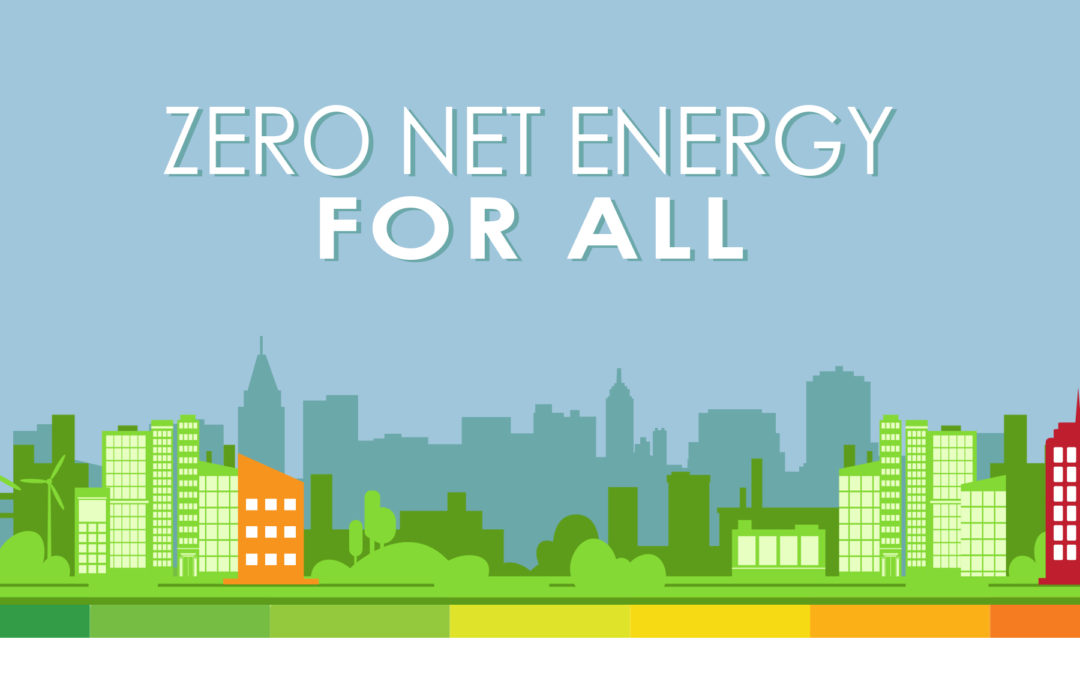Buildings consume almost half of the energy produced in the United States and produce 45% of all greenhouse gas (GHG) emissions. However, energy savings and GHG reducing opportunities in commercial and residential buildings remain untapped. There is a solution, and it has gained momentum but lacks traction, and that is Zero Net Energy (ZNE) also referred to as Zero Energy (ZE) and Net Zero Energy (NZE) and therein lies a glimpse of the issue. ZNE over-laps several industries and is impacted by numerous governing bodies all of which have their own terms, definitions, and jurisdictions. By and large, this hinders policy development, implementation, and even classification. How do we better define something that is broad in audience and ambition yet greatly in need of clarification to make it universal?
For us to understand how to implement ZNE and make it more inclusive, it is imperative to understand ZNE at its core, including the key benefits and importance of building sustainably. Since the definition of a ZNE building differs depending on whom you ask, at a basic level it’s like a balance sheet, a building that produces as much energy as it consumes over the course of a year. ZNE buildings remain connected to the grid; and, depending on their configuration can produce more energy than they can consume—either pushing excess power back to the grid or storing excess power on-site. While the basic concept of what a constitutes a ZNE building is generally agreed upon, there continues to be much debate regarding the nuances and qualifications of ZNE.
Building professionals, industry stakeholders, and the government all use multiple definitions to determine what amount of renewable energy is necessary to offset a building’s energy use. These various definitions account for variables that affect the energy balance sheet such as energy generation, transmission, delivery, and distribution losses. The main goal of these current definitions largely focuses on determining a building’s renewable offset, but limit the type of buildings and scope of projects that could qualify for ZNE classification, especially in urban areas.
A key issue is defining the building system ‘boundary’ or where the renewables are located. The founding principles of ZNE insisted that renewables be located within the building footprint or on-site. Great for new construction, but as ZNE transitioned from theory to practice, experts quickly realized that ZNE is often not possible with many existing buildings and the restrictive definition was inhibiting the expansion of ZNE to broader applications. With an increase in city and state ZNE-related initiatives, the call for more flexible definitions was tackled by The U.S. Department of Energy which established the following four ZNE definitions:
- Zero Energy Building: The building footprint (i.e., rooftop), or the building site (i.e., parking lot, adjacent land) must be utilized for an on-site renewable generation.
- Zero Energy Campus: A multi-building campus can be utilized for on-site renewable generation to offset the energy use of all or a portion of the campus buildings. This approach allows ZNE to be achieved as a whole when some of the buildings within the campus footprint are limited in capacity for on-site renewables.
- Zero Energy Portfolio: A single owner of multiple building sites could aggregate its buildings so that the combined on-site renewable energy generated would offset the combined building energy use.
- Zero Energy Community: An energy-efficient community where the annual delivered energy is less than or equal to the on-site renewable exported energy.
Buildings in urban areas face the greatest challenges to becoming self-sustainable and are often left by the ZNE wayside. Buildings that occupy large footprints often have difficulty implementing simple energy-efficiency measures necessary for achieving ZNE, such as leveraging natural ventilation and daylighting. For buildings that exceed three stories, the ratio of energy demand to the potential for energy production is high. For these buildings, ZNE efforts could be hindered by the cost and complexity of adding structural support to the roof to accommodate the weight of solar panels. Other buildings that lack surrounding parking lots or green spaces are challenged to find suitable areas to situate renewable energy systems such as wind or solar. These building scenarios, due to their boundary limitations, have little chance of cost-effectively being converted to ZNE status.
Lowering energy loads for all buildings is desirable, with the greatest need being in urban environments and communities, yet these areas require more flexibility and an increase in creativity to help develop policies and conditions that make achieving ZNE possible. By broadening the definition of ZNE boundaries and where renewables can be sited, we expand the potential for how ZNE can be achieved in an urban or community setting. Understanding how to calculate the needed renewable energy offset to achieve ZNE, and where to physically locate the sources for renewable energy supplies are important details. They are key when determining how to utilize ZNE principles in state and local policies, as well as factor into where resources and funding are directed. By broadening how we define ZNE, not just for new construction, but for existing buildings as well, we will ultimately help all stakeholders keep the focus on the spirit of ZNE’s end-goals; energy efficiency and reducing the carbon footprint, because that’s a balance sheet worthy of the effort.
References:
U.S. Department of Energy. (September 2015) A Common Definition of Zero Energy Buildings.
Retrieved from: www.energy.gov
File: bto_common_definition_zero_energy_buildings_093015.pdf
By: Dr. Ellen Steiner
Contact: esteiner@opiniondynamics.com

